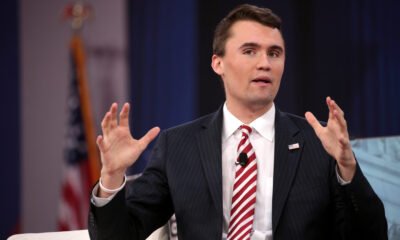World News
Dan Gwak of Point72 Ventures on why defense tech is becoming the next big thing for investors on August 5, 2023 at 4:48 am
Dan Gwak has had a more varied life than many investors. He grew up in Jakarta, the son of Korean parents who ran a shipping business. After high school, he headed to Cornell in the U.S., and became an associate at The Carlyle Group.
Everything was moving up and to the right, so to speak. Then, like a gut punch, the financial recession hit in 2008.
Gwak was among many who suddenly found themselves on uneven footing and evaluating their next steps. Unlike most of his young investing banking peers, Gwak quickly decided to join the U.S. Marine Corps as a machine gunner. It seemed like a natural decision, given that in Korea, where military service is compulsory for men between ages 18 and 35, both Gwak’s father and brother had served. It was also Gwak’s way of “becoming American,” he says.
While he wasn’t expecting his service to end four years later in Afghanistan – he was wounded and sent home – Gwak again didn’t waste much time deliberating about his next moves. He applied and was accepted to Harvard Business School, and nearly since that time, he has been investing at the intersection of national security and technology. Out of school, he joined In-Q-Tel, which is the venture arm of the CIA. In 2017, when the billionaire hedge fund manager “Stevie” Cohen decided to build out a venture practice — Point72 Ventures — he poached Gwak, and Gwak has remained active since, including leading a 50-person team that has invested more than $1 billion into roughly 130 companies on Cohen’s behalf.
The deals range across four key areas: deep tech, fintech, enterprise and defense tech. But in a lengthy conversation with Gwak earlier today, he talked the longest about defense tech as he’s passionate about it and because the way he sees it, Washington is focused more than ever on the global balance of power — and looking for any edge it can find. Below are excerpts from that part of our chat, edited lightly for length and clarity. You can listen to the entire conversation here.
TechCrunch: You have these four areas on which you’re focused, but fintech has cooled off after several frothy years, defense tech now seems top of mind for investors. Is that true inside Point72?
Dan Gwak: Absolutely. If you rewind the clock, fintech was an area that was very hot and we were very active in deploying a lot of capital. Today, the area that’s really come up is defense tech. It’s not just that the market in general has corrected, but rather, I think defense tech, specifically as an opportunity, has really [gained traction] among other venture investors, as well as founders [along with a growing] awareness of the importance of defense tech to the government.
Given your experience over the years, working for and selling to the government, does the sales process move any more quickly than historically? The longstanding knock, of course, is that it’s too bureaucratic and there’s too much red tape to get past.
Even five years ago, I would have told you that defense tech investing the way that we think about it – which is investing in companies whose primary customer is going to be the Department of Defense – is a bad idea for exactly the reason that you describe. But that has changed for a couple of big reasons. First of all, the government is generally inefficient at buying things until something comes along that has the potential to shift the global superpower balance, and that’s what you’re seeing today. If you look at the last time that happened, that was probably pursuing the atom bomb and the Manhattan Project. When you look at things like AI and all the ways it applies – whether that’s autonomy or computer vision or natural language processing – these are all things that absolutely can shift the global superpower balance, and the government sees that now. And when the government sees that, then it becomes much, much better at buying things.
It seems like a portfolio company of yours, Shield AI, falls into this category. [Editor’s note: Shield AI develops AI-powered fighter pilots and drones that it sells to the U.S. Air Force and U.S Army.]
Autonomous drone swarms do have the ability to shift the global superpower balance, whoever gets that right and can release a drone swarm of thousands. That is an approach [against which there are] just not good defenses against today, even if you own the largest aircraft carrier fleet in the universe. [And because a company like Shield AI can help in] the future preparedness of America, it can, as a result, get a lot of the funding that comes out of the government. It used to be because of the slower sales cycles and so forth, you had to kind of count on the prize being larger but taking longer to get to. [Today] we’re finally entering a time where, as long as you align with something that really, really matters to the government and you can connect the dots effectively, you can grow that business as quickly as as any commercial business,
What has Ukraine meant for its business?
Ukraine’s impact on defense tech has been a very catalyzing one. Everyone understood even before Ukraine that drone swarms and the effective use of attritable technologies and things like that could have a very big impact. Ukraine just serves to highlight that In real life. When you look at what’s going on there, that effective use of drones has had a massive impact in that battlefield.
So-called slaughterbots are autonomous drones that are programmed to kill people without any human intervention. How does a company like Shield AI deal with potential customers that might misuse its technology?
I don’t want to speak on the company’s behalf on that topic because it is a conversation that the company should have with its customers, and I’m not necessarily in those conversations. However, I think the overall topic — the danger posed by autonomy when it comes to taking human beings out of that decision to attack — is a very interesting one. To my mind, it’s all about system design. Any weapon in the world that has a kinetic effect can be very, very dangerous — to the enemy, to ourselves, and to noncombatants who just happen to be in the wrong place at the wrong time.That’s why when you look at all these kinetic systems, there’s always good system design around the decision to take an action, and a human being is usually in the loop. When it comes to this new wave of technology, it’s not like we’re throwing that concept of safety out the window. Good, sound, system design, as informed by the risks that we are willing to subject ourselves to, is always going to be an important part of the equation.
The U.S. government is a big customer that can demand that things are tailored for its purposes. Does it preclude these companies from selling to other governments? How does that work? Do they have to get buy in from Washington?
It depends on what other country we’re talking about [laughs]. To contextualize with numbers, though, the overall spending of the United States and all of its allies on defense is $1.6 trillion. That is a gigantic market. It is an order of magnitude larger than the commercial SaaS market. Of that 1.6 trillion, fully 50% of it is just the U.S. So when you see defense tech companies so focused on the U.S. defense market, there’s a good sound reason for that. That [also] means that if that largest part of the market is asking you not to interact with nations that might be adversarial to the United States, you’re going to respect that.
Are the investors interested in these deals changing at all? I know who some of the players are — you, In-Q-Tel, Lux. . . .
Lux is certainly one that’s been investing where deep tech meets defense tech for a while. [There]’s also Founders Fund, 8VC, a16z as part of their American dynamism effort. There is a core group of half a dozen or so that have been focused on defense tech for for a while. Now I’m seeing additional investors, tier one venture investors, who were not necessarily historically interested in defense tech, start to be a lot more interested. That that’s a good thing. The opportunity is just so large. If you think about it, the DoD has an $800 billion budget and only 1% of that today goes to startups.
That’s an incredible stat. I guess I have the headline to this story now. Who gets the rest? Lockheed Martin?
It’s largely the defense primes today, which serve an important purpose. But the truly transformational technologies that the DoD needs to be able to harness in the next 10 years, those are going to come from startups.
Dan Gwak has had a more varied life than many investors. He grew up in Jakarta, the son of Korean parents who ran a shipping business. After high school, he headed to Cornell in the U.S., and became an associate at The Carlyle Group. Everything was moving up and to the right, so to speak.
Politics
Netanyahu’s UN Speech Triggers Diplomatic Walkouts and Mass Protests

What Happened at the United Nations
On Friday, Israeli Prime Minister Benjamin Netanyahu addressed the United Nations General Assembly in New York City, defending Israel’s ongoing military operations in Gaza. As he spoke, more than 100 delegates from over 50 countries stood up and left the chamber—a rare and significant diplomatic walkout. Outside the UN, thousands of protesters gathered to voice opposition to Netanyahu’s policies and call for accountability, including some who labeled him a war criminal. The protest included activists from Palestinian and Jewish groups, along with international allies.

Why Did Delegates and Protesters Walk Out?
The walkouts and protests were a response to Israel’s continued offensive in Gaza, which has resulted in widespread destruction and a significant humanitarian crisis. Many countries and individuals have accused Israel of excessive use of force, and some international prosecutors have suggested Netanyahu should face investigation by the International Criminal Court for war crimes, including claims that starvation was used as a weapon against civilians. At the same time, a record number of nations—over 150—recently recognized the State of Palestine, leaving the United States as the only permanent UN Security Council member not to join them.
International Reaction and Significance
The diplomatic walkouts and street protests demonstrate increasing global concern over the situation in Gaza and growing support for Palestinian statehood. Several world leaders, including Colombia’s President Gustavo Petro, showed visible solidarity with protesters. Petro called for international intervention and, controversially, for US troops not to follow orders he viewed as supporting ongoing conflict. The US later revoked Petro’s visa over his role in the protests, which he argued was evidence of a declining respect for international law.

Why Is This News Important?
The Gaza conflict is one of the world’s most contentious and closely-watched issues. It has drawn strong feelings and differing opinions from governments, activists, and ordinary people worldwide. The United Nations, as an international organization focused on peace and human rights, is a key arena for these debates. The events surrounding Netanyahu’s speech show that many nations and voices are urging new action—from recognition of Palestinian rights to calls for sanctions against Israel—while discussion and disagreement over the best path forward continue.
This episode at the UN highlights how international diplomacy, public protests, and official policy are all intersecting in real time as the search for solutions to the Israeli-Palestinian conflict remains urgent and unresolved.
News
Is a Nuclear-Powered Alien Spacecraft Flying Toward Earth?

A mysterious interstellar object speeding through our solar system has reignited debates about extraterrestrial technology — and whether Earth might currently be under quiet observation.
The object, known as 3I/ATLAS, is only the third confirmed interstellar visitor ever detected. Unlike ordinary comets, however, this cosmic traveler has baffled astronomers with its unusual brightness, strange trajectory, and lack of a visible cometary tail. While most scientists cautiously describe it as a natural body, one leading astrophysicist believes something much stranger is at play.

Harvard Scientist’s Bold Claim
Professor Avi Loeb of Harvard University, head of the Galileo Project, has suggested that 3I/ATLAS may in fact be a nuclear-powered alien spacecraft designed to test how humanity would respond to an interstellar visitor. He argues that its flight path is improbably precise, bringing it close to Mars, Venus, and Earth — a pattern highly unlikely to occur by chance.
Loeb also points out that telescope images show a glow inconsistent with ordinary dust behavior. Instead of trailing behind like a comet, the halo-like light appears to extend in unusual ways, sparking debate about whether the object could be emitting energy of its own.
Headed Toward Earth’s Neighborhood
3I/ATLAS is expected to make its closest approach in late 2025, passing near Mars before swinging by the inner solar system. Although Earth itself will be on the opposite side of the Sun when it comes closest, the alignment will still enable space-based observatories to capture sharper data.

Loeb has called on NASA and other agencies to use spacecraft already stationed near Mars or Jupiter — including the Juno mission — to take high-resolution photographs. He believes such efforts could reveal whether the interstellar object is truly natural, or the first technological probe humanity has ever encountered.
Should We Be Worried?
While most astronomers argue caution before jumping to alien conclusions, Loeb insists that scientific openness is key. “If it’s just a comet, we learn something new,” he said. “But if it’s a spacecraft, it would be the most important discovery in human history.”
For now, 3I/ATLAS remains a mysterious speck on astronomers’ charts, drifting closer with each passing day. Whether it proves to be a frozen remnant of another star system or something far more advanced, the interstellar visitor has already succeeded in one mission: reminding us how vast and unpredictable the universe really is.
News
AI Automation Could Cause Up to 20% Unemployment—A Workforce on the Brink

Stark Warning from Anthropic CEO Highlights Rapid Job Displacement Risk
The looming threat of widespread unemployment due to AI automation has sparked intense debate among experts, business leaders, and policymakers. Dario Amodei, CEO of Anthropic—the company behind the influential AI language model Claude—issued a stark warning that has sent shockwaves through corporate America:

“Up to half of all entry-level white collar jobs could disappear within the next one to five years, potentially pushing unemployment rates as high as 20% during this period.”
This dramatic forecast paints a picture of a rapid and unsettling transformation in the workforce, driven by AI technologies that can perform complex cognitive tasks.
Balancing Predictions: Worst-Case Scenarios vs. Moderate Impact
However, this forecast represents one end of a spectrum of expert predictions. While Amodei’s warning highlights the worst-case scenario driven by the swift adoption of AI agents capable of coding, analyzing data, drafting legal documents, and managing workflows around the clock, other analyses suggest a more moderate impact. For example, Goldman Sachs estimates that AI could temporarily displace about 6-7% of U.S. jobs, with unemployment rising by approximately half a percentage point during the adjustment period. Their research anticipates a more gradual transition with a mixture of job disruption and creation.

The Unprecedented Speed and Scope of AI-Driven Job Disruption
The truth likely lies somewhere in between. AI is advancing at unprecedented speed, and the scope of jobs affected spans far beyond blue-collar roles to white-collar positions that required college degrees and years of training. Entry-level roles such as customer service representatives, data entry clerks, junior analysts, and administrative assistants face the greatest near-term risk. Mid-level roles in accounting, marketing, law, and engineering could soon follow, with companies already laying off workers citing AI-driven efficiencies.
Preparing for an AI-Transformed Workforce: Adaptation Is Essential
Ultimately, the AI-driven job transformation is no longer a distant prospect but unfolding now. Whether unemployment spikes to 20% or stabilizes at lower levels depends on many factors, including business adoption rates, government policies, and the ability of workers to reskill. What is certain is that the workforce of tomorrow will look very different from today—and the time to prepare is right now.

 Business3 weeks ago
Business3 weeks agoDisney Loses $3.87 Billion as Subscription Cancellations Surge After Kimmel Suspension

 Entertainment3 weeks ago
Entertainment3 weeks agoWhat the Deletion Frenzy Reveals in the David and Celeste Tragedy

 Filmmaking4 weeks ago
Filmmaking4 weeks agoThe Real Reasons Film Jobs Are Disappearing

 Entertainment4 weeks ago
Entertainment4 weeks agoABC Suspends ‘Jimmy Kimmel Live!’ Indefinitely After Kirk Remarks

 Tech4 weeks ago
Tech4 weeks agoWhy Experts Say AI Could Manipulate, Blackmail, and Even Replace Human Relationships

 News4 weeks ago
News4 weeks agoSeeing Trauma: What Charlie Kirk’s Death Reveals About a Nation in Conflict

 Entertainment3 weeks ago
Entertainment3 weeks agoExecutive Producer Debut: How Celia Carver Created Festival Hit ‘Afterparty’

 Filmmaking4 weeks ago
Filmmaking4 weeks agoWhy Hollywood’s Biggest Blockbusters Keep Failing at the Box Office






























